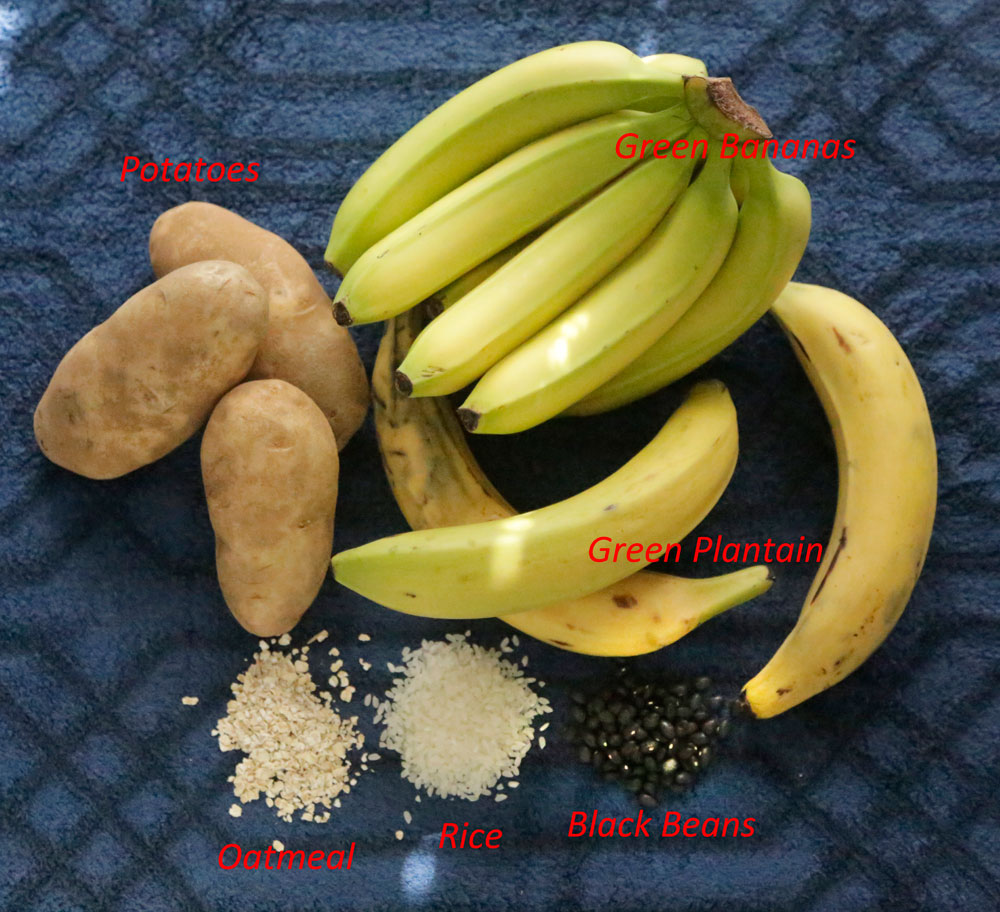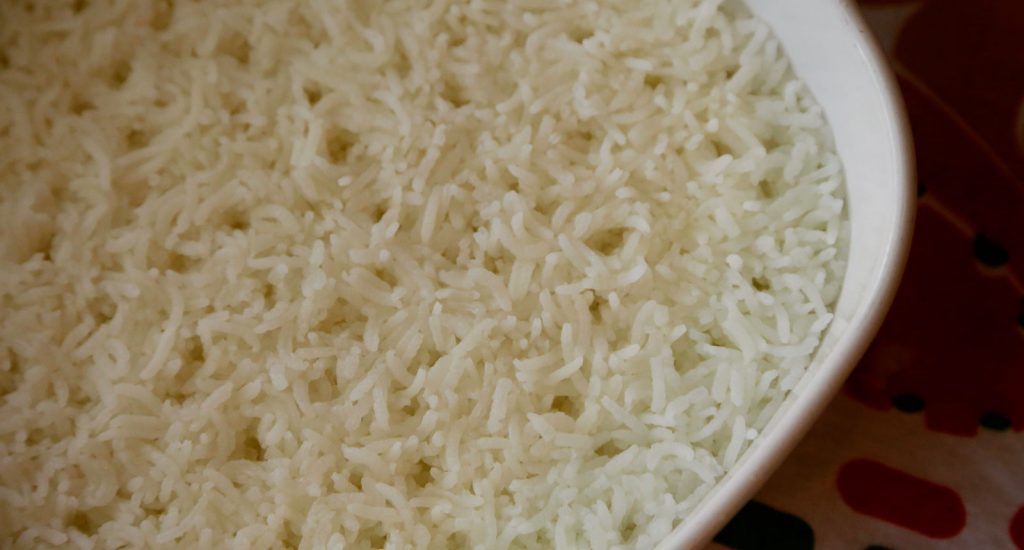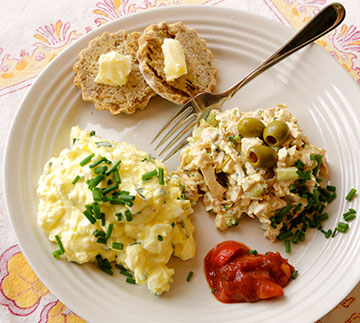Resistant Starch is part of a balanced diet, providing fiber with many health benefits.

- Foods containing resistant starch help curb appetite, and provide food for the natural flora and fauna in the gut.
- Foods with Resistant Starch lower blood sugar levels and improve insulin sensitivity.
- Resistant Starch also creates Butyrate, a type of fatty acid regulating gut function.
Starch-containing foods often give us a feeling of satisfaction and fullness. Some examples of Starch-containing foods are bread, potatoes, rice, green bananas, plantain, oatmeal, and beans.
What role does Starch play in your diet?
Foods containing Starch play a significant role in supplying the metabolic energy that enables the body to function. Although Starch has been given a “bad rap” in recent years, it is part of a well-balanced diet. The keyword here is BALANCE. Eating just the right balance of Starch and including a goodly amount of food containing sources of Resistant Starch will enhance your overall diet. As they say, “Eat everything in moderation!”
Starch-containing food is the most important source of carbohydrates in a balanced diet. The rate at which different types of starches are hydrolyzed and absorbed in the digestive tract varies. You can eat better-balanced meals by understanding starch-containing foods and their varying proportions and types of Starch. Consuming more resistant starch foods can lead to better digestive health.
The following are the three classifications of Starch.
- Rapidly digestible Starch
- Slowly digestible Starch
- Resistant Starch
About Rapidly Digestible Starch
Plants form starches called complex carbohydrates. These starches can put on weight if you don’t use all that energy. Conversely, they supply you with much-needed energy. When you eat starchy foods, an enzyme called amylase is found in your saliva, and the small intestine breaks down the starches for accessible fast energy.
About Slowly digestible Starch
These are referred to as “extended energy-releasing starches,” which offer a slow and sustained release of blood glucose referred to as having a “Low Glycemic Index.”
About Resistant Starch
Foods containing Resistant Starch alter their starch profile based on their preparation. With resistance to digestion, these starches have less effect on blood glucose or insulin levels and calories.
The Four Categories of Resistant Starch are as follows.
Category 1: Found in the fibrous cell walls of whole grains, seeds, and legumes.
Category 2: Found in Raw Potatoes, Green Plantain, and Green Bananas. These are Resistant Starches that exhibit resistance properties when the foods containing them are eaten in the ‘raw’ state. Once cooked, the Starch is then digested before entering the colon. Eating these in their raw form is more palatable in smaller amounts or added to smoothies.
Potato Starch (a Category 2), the dry powder often used as flour, contains the largest concentration of resistant Starch available. It is usually only used for baking, which removes the resistant starch benefits, but small amounts can also be added to smoothies. Potato Starch is made from raw potatoes. If you grate a raw potato and add water to strain out the pulp, you will find a fine silt-like mass left in the bottom of the container, the ‘resistant starch’ part of the potato. This is what potato starch is. Potato flour is made from the entire potato.
Category 3: Found in Cooked and then Cooled Potatoes, White and Brown Rice, Legumes, Oatmeal, Green Plantain, and Green Bananas. Because these foods are challenging to eat raw, if you want to increase the resistant starch benefits, let them cool after cooking. Use in salad-type meals rather than reheating.
Who knew that the rice or potato salad you love is actually a form of healthy, Resistant Starch?

See Recipes for A Resistant Starch Dinner Menu
From a technological standpoint, resistant starch type 3 is the most important since their formation is a result of food processing. The amylose content, temperature, physical form, the degree of gelatinization, cooling, and storage affect its contents. The content of resistant starch in foods can be changed by relatively simple processing techniques, influencing the rate and expected extent of starch digestion
in the human intestine.
A little about Butyrate
So, what is Butyrate, you ask? Butyrate is part of the colonic mucus layer protecting the intestinal epithelium lining. It is produced during the fermentation of dietary fibers and plays a crucial role in colonic health.
So many who have Celiac Disease or Gluten Sensitivity have long-standing digestive issues due to the length of time it took to diagnose their problem. As a result, they have sometimes become sensitive to many other foods, especially in the early stages of changing their diets.
In the first weeks and months of entering a gluten-free diet for life, you learn through trial and error, and you find out what foods are best for you. On a positive note, since I’ve helped many people start out successfully with a gluten-free diet, I have found that once on this diet for some time, foods that once caused a problem can often be re-introduced as long as they are gluten-free.
One friend I worked with could not eat beans for the first two years. Once on a gluten-free diet, beans were slowly introduced with good results. In the early days of healing the gut, you can have a relapse of old symptoms even though you are sure you didn’t eat gluten. It can take up to two years to heal sufficiently, which is why cheating or eating gluten without knowing it can be challenging. Another friend that I helped change her diet had developed other food sensitivities.
Cassava Resistant Starch
Cassava is the same starch by 3 different names, manioc and yuca, and cassava.
Cassava flour or Starch is made from the entire manioc or cassava root. It contains many of the nutritional elements available in the root. It is naturally gluten-free. It is a high carbohydrate or rapidly digestible Starch, but paradoxically, it has a low glycemic index and also contains some resistant starch. Cassava contains saponins which can help ease inflammation. It also contains several essential minerals and properties that balance gut flora and fauna.
Tapioca is an extract of the Cassava root. It does not have as many health benefits as Cassava Flour, yet its uses are varied and beneficial. It also has some resistant starch qualities.
Cassava roots are used instead of potatoes in many cultures. They contain almost twice the calories. Cassava is a significant source of fiber and natural sugar and contains about 3 grams of protein per root.
Cassava recipes are great for those on a gluten-free diet. Many people suffering from Celiac have a problem gaining weight. (Other Celiac have a problem losing weight) Cassava can help those who are underweight regain a healthy weight. The Philippines’ Department of Science and Technology states, “Because cassava root has a low hypoglycemic index, it is also a good choice, in moderation, for diabetics.”
Cassava Roots can be stored at room temperature for about a week. They are prepared by peeling them, then boiling, baking, or frying. They can also be dried or fermented for later use. If Cassava is not prepared and cooked correctly, it can cause cyanide poisoning; it is therefore recommended to buy Cassava Root Flour that has already been processed.
Cassava Nutrition: B-complex vitamins – folate, thiamin, pyridoxine (vitamin B6), pantothenic acid (vitamin B5), and riboflavin (vitamin B2). Cassava contains saponins that help reduce inflammation, break down wastes such as uric acid, cleanse mineral deposits from joints, and assist gut flora and fauna. The root also includes several essential minerals throughout your body, such as Iron, Zinc, Calcium, Magnesium, Potassium, and Manganese.
Cassava contains more than one form of cyanogenic glycoside — sweet and bitter: “Different varieties of Cassava are generally classified into two main types: sweet and bitter. Sweet cassava roots contain less than 50 mg per kilogram hydrogen cyanide on a fresh weight basis, whereas that of the bitter variety may contain up to 400 mg per kilogram.”
So is Resistant Starch good for everyone?
Too much Resistant Starch can worsen digestive issues if you’re trying to heal from any digestive or GI illness, infection, or overgrowth of bacteria. SIBO (small intestinal bacterial overgrowth) or IBS, Irritable Bowel Syndrome, Crones, or another issue that you may be dealing with means you must limit your intake.
Always seek advice from your health professional.
Add very low amounts of resistant Starch at a time to see how you react.
You can’t go wrong with eating some delicious, whole foods cooked just right and cooled so that they maintain all their nutritional properties.






Hi, I really enjoyed this article! Regarding the resistant starch found in cooked and then cooled foods “if you are looking to increase the resistant starch benefits, let them cool after cooking. Use in salad type meals rather than re-heating.” What happens if I cook and cool the food and then I reheat the food afterwards? Does it keep the resistant starch benefits?
Angela
Hi Angela,
Glad you enjoyed the article. In my research, there have been studies showing that re-heating rice, for instance, retains more resistant starch properties than freshly cooked rice. Not quite as much as cold, but reasonably significant. I like to cook ahead and save time with meal preparation, so I often use leftover cold rice or potatoes in a stir fry or other recipe rather than just in a salad. Here is a link if you are interested in seeing the results of a study. https://pubmed.ncbi.nlm.nih.gov/26693746/
All the best,
Trina
PS: Please note that cooked rice needs to be refrigerated as soon as it cools or becomes warm to the touch. It can last up to 5 days once refrigerated. If left at room temperature for several hours or overnight, it can taste ok but still have what is called “Fried Rice Syndrome” (also applies to plain cooked rice). This is because unrefrigerated cooked rice can develop a bacteria called Bacillus cereus which can grow in the rice and cause food poisoning. See more at this link https://www.sfa.gov.sg/food-information/risk-at-a-glance/fried-rice-syndrome
Nice article. We need this type article to get the awareness. Not all calories the same. Not all the carbs are the same. Thanks a lot.
Thanks for your comment. Yes, there are too many foods that are just empty calories. A balanced diet is best. I will try and post more articles like this one.